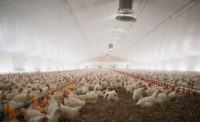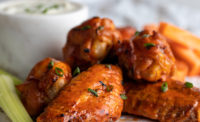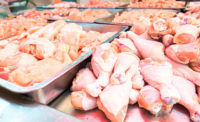Waiting for the game changer” characterizes the chicken industry’s outlook as producer/processors begin to turn the calendar to the New Year.
More specifically, confidence continues to build that the African Swine Fever (ASF) epidemic in China and at least seven surrounding Southeast Asian countries will require these countries to import an unprecedented quantity of pork, poultry, beef and other animal proteins.
When China first reported ASF in August 2018, the market reaction in the United States was that there would be a somewhat immediate increase in Chinese demand for animal protein from many international sources. It was not, however, until mid-2019 that China’s demand for more imported meat became evident.
State of the Industry 2019
OverviewBeef (NCBA)
Pork
Chicken
Food Safety
Packaging
Beef (CAB)
Turkey
Veal
Lamb
Animal Welfare
Seafood
Workforce
Watch the 2019 State of the Industry Webinar
Register for free today!
While “20/20” suggests good eyesight, there are still many questions and issues that cloud the outlook for the year 2020. Let’s look domestically first.
One record that has been broken annually since 2013 and continues to be broken is chicken consumption (see Annual Broiler Forecasts table).
Combined poultry and red meat consumption could reach more than 225 pounds per person in 2020 compared with more than 220 pounds in 2018. For consumers to be motivated to eat about five more pounds of poultry/red meat in 2020 will require a continued good U.S. general economy, low unemployment and retail poultry/meat prices favorable to consumers.
Boneless, skinless thighs continue to gain acceptance by consumers both as a product itself and as the primary ingredient in chicken sausages, breakfast and gourmet.
The #ChickenSandwichWars helped to boost consumption, as well. The summer debate over which restaurant chain serves the best chicken sandwich helped boost overall sales in the quick-service restaurant segment in August 2019, according to a report by the NPD Group.
Back overseas: For U.S. chicken, the likelihood of if or when product will again be permitted to be exported to China remains the most important issue. Unfortunately, since the 2015 avian influenza outbreak in turkey and layer flocks across the Midwest, China has maintained a blanket ban on all U.S. poultry and egg products, including breeding stock. At its peak in 2008, China was a $715 million market for broilers.
ANNUAL BROILER FORECASTS
| 2016 | 2017 | 2018 | 2019 | 2020 | |
| Production (million lb.) | 40,696 | 41,662 | 42,601 | 43,311 | 43,800 |
| Per capita disappearance (retail lb.)* |
89.8 | 91.0 | 92.4 | 93.5 | 93.9 |
| Broiler exports (million lb.) |
6,645 | 6,786 | 7,069 | 7,121 | 7,250 |
Forecasts are in bold. * Per capita meat disappearance data are calculated using the Resident Population Plus Armed Forces Overseas series from the Census Bureau of the Department of Commerce. All data as of Aug. 15, 2019. Source: World Agricultural Supply and Demand Estimates and Supporting Materials. For further information, contact: Mildred M. Haley, mhaley@ers.usda.gov
USDA forecasts chicken production in 2020 to be little more than 1 percent over 2019. This expected increase is even more modest than the less than 2 percent USDA sees for 2019.
A number of analysts believe the six new or rebuilt chicken complexes that came online in 2019 or will do so in 2020 offer the potential to ramp up chicken production measurably beyond 1 percent. Also, more than 100 plants are in the process of increasing evisceration line speed from 140 birds per minute to 175. While moving toward the more efficient line speed will likely take all of 2020 and beyond to achieve, it does indicate companies continue to see good demand for chicken at both home and abroad.
Usually, when USDA reports an expected increase in production of chicken or other animal proteins, it estimates an accompanying decrease in the producer or wholesale price associated with that protein.
However, USDA is now reporting for 2020 increased production for all poultry and meat and, at the same time, higher prices to be received by all animal producers. USDA analysts also see a game changer coming.
PROCESSED FRZ. FROZEN/ REFRIG. CHICKEN/ CHICKEN SUBSTITUTE:
TOP 10 RETAIL BRANDS
| Brand | Dollar Sales | Dollar Sales % Chg YAgo | Unit Sales | Unit Sales % Chg YAgo |
| Tyson | $871,366,438 | 1.1% | 129,207,215 | 4.0% |
| Private Label | $556,664,554 | 8.7% | 85,669,900 | 3.4% |
| Tyson Any'tizers |
$282,249,607 | -3.1% | 40,157,526 | -2.1% |
| Perdue | $186,674,535 | 0.5% | 41,156,044 | 3.7% |
| Tyson Grilled & Ready |
$173,834,934 | -4.2% | 23,531,780 | -2.9% |
| Foster Farms | $124,655,812 | -4.4% | 19,869,477 | -5.3% |
| John Soules Foods |
$115,641,909 | 4.3% | 28,299,372 | 6.0% |
| Banquet | $96,062,993 | -6.1% | 18,624,712 | -12.2% |
| Perdue Short Cuts |
$90,900,265 | 0.5% | 24,799,646 | 2.2% |
| Innovasian Cuisine |
$56,508,222 | 27.4% | 10,080,775 | 23.4% |
| Total Processed Frz./ Refrig. Chicken/ Chicken Substitute |
$3,098,735,321 | 1.7% | 513,448,637 | 1.8% |
| Total Processed Frozen/Refrig. Poultry |
$3,167,156,379 | 1.9% | 525,646,705 | 1.9% |
FROZEN/ REFRIG. CHICKEN/ CHICKEN SUBSTITUTE:
TOP 10 RETAIL BRANDS
| Brand | Dollar Sales | Dollar Sales % Chg YAgo | Unit Sales | Unit Sales % Chg YAgo |
| Private Label | $979,561,245 | 0.6% | 126,667,270 | -11.2% |
| Tyson | $369,508,711 | -17.8% | 44,464,640 | -11.7% |
| Perdue | $113,638,367 | 13.2% | 25,580,122 | 13.2% |
| Kraft TGI Friday's | $103,088,500 | 6.6% | 22,385,565 | 7.8% |
| Barber Foods | $81,552,890 | 3.3% | 12,392,132 | 2.9% |
| Perdue Perfect Portions |
$80,172,749 | -0.3% | 10,687,396 | 5.9% |
| Just Bare | $70,356,297 | 1.1% | 9,888,457 | -1.6% |
| Perdue Harvestland |
$58,531,780 | 24.4% | 10,717,065 | 28.6% |
| Gardein | $49,449,272 | -3.4% | 11,201,047 | -8.5% |
| Gold Leaf | $42,769,151 | -9.1% | 7,374,722 | -4.8% |
| Total Frozen/ Refrig. Chicken/ Chicken Substitute |
$2,526,446,510 | -5.7% | 387,745,270 | -7.7% |
| Total Frozen/ Refrig. Poultry |
$4,051,032,100 | -3.3% | 686,468,692 | -5.4% |
Source: IRI, a Chicago-based market research firm (@iriworldwide). Total US Multi-Outlet w/ C-Store (Grocery, Drug, Mass Market, Convenience, Military and Select Club & Dollar Retailers), latest 52 weeks ending Aug. 11, 2019.
Note: Rankings of top brands are NOT totaled brand listings (e.g. all UPCs or brand extensions rolled up into a single figure, such as Total Crest Toothpaste), but are rather individual brand listings.
If China does re-open its market to U.S. chicken, the most immediate benefit will be exporting feet/paws. No additional chickens will need to be produced to meet this marketing opportunity, just a shifting of product from rendering to USDA inspection for export packaging.
Reportedly, China has indicated a willingness to consider importing pork, chicken, beef and other agricultural animal proteins on a contract-by-contract basis from countries that may not have normal trade relations with China. High import duties could also be waived under this program as China may try to moderate the consumer price inflation for pork and poultry.
If China does, in fact, import substantial quantities of U.S. chicken leg quarters and/or other back-of-the-bird parts, U.S. chicken companies will need to determine a profitable market for breast meat before they ramp up production. To accomplish an acceptable balance between the supply/demand for white meat/dark meat more than one outrageously popular quick-service chicken sandwich will have to hit the market.
It is becoming more evident that there will be significant “gap” between China’s usual production/consumption level of pork and how the shortfall will be filled. After adjusting for increased imports, drawdown of frozen inventory of pork and normal demand destruction caused by higher consumer pork prices, there will be a 5 to 10 million metric ton “gap” that cannot be filled. Depending on the strength of the Chinese general economy, additional demand destruction will have to occur.
Suppliers of pork and poultry who can service the Chinese market will significantly benefit, not just in 2020 but until a vaccine or some other breakthrough is discovered and successfully implemented in the affected countries. That timetable is most likely to be five years or more. An effective vaccine will be a major achievement because ASF has been infecting hogs for many decades. More than 40 countries have been exposed to this disease. Complicating the challenge to finding an effective vaccine is the very difficult issue that there are more than 20 variations of the virus.
The magnitude and duration of the game change will become more evident in 2020. NP









